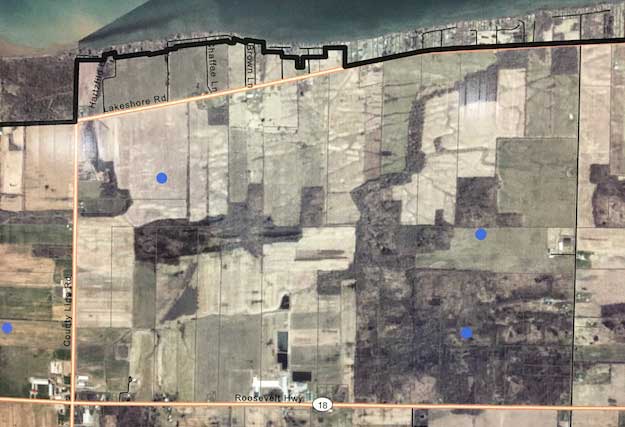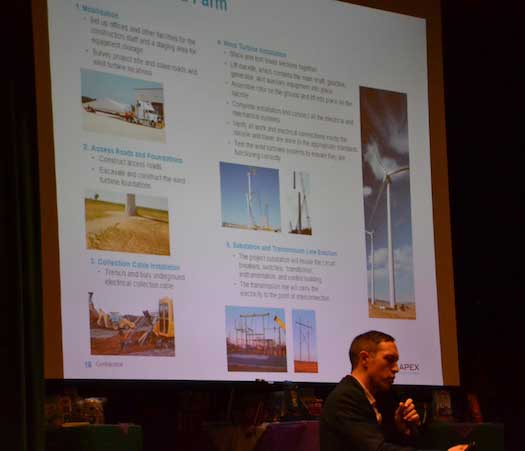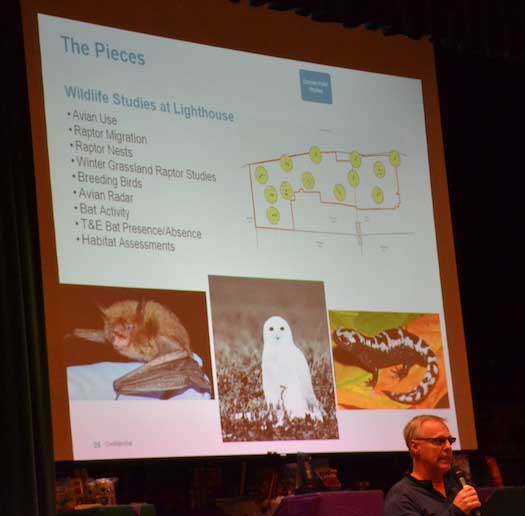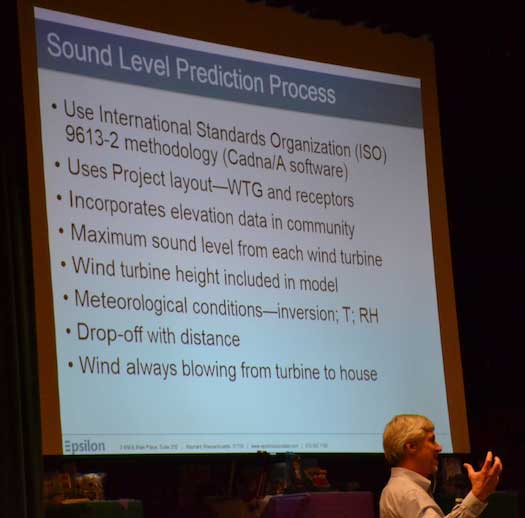Apex unveils layout of Lighthouse Wind, with 8 turbines proposed for Yates and 39 for Somerset
‘This is a fantastic vehicle to make this a high value area to live and work.’ Paul Williamson, Apex project manager
LYNDONVILLE – Apex Clean Energy presented the proposed layout of a turbine project that has been about four years in the works. The project would have fewer turbines than initially presented. The turbines would be the latest model and would generate more power, 4.2 megawatts, while emitting less noise, Apex officials said.
The 47 turbines would generate 197.4 megawatts. Apex is proposing that eight turbines be in Yates while 39 are planned for Somerset. The turbines would have a hub height of 345 feet and a maximum tip height of 591 feet. Apex wants to build the latest model, a Vista V150 (4.2).
Paul Williamson, project manager for Apex, told a crowd of about 150 people at the Lyndonville school auditorium, that the project would be a major investment in the community, reducing taxes, diversifying employment opportunities and helping to strengthen some of the local farms.
“This is a fantastic vehicle to help make this a high-value area to live and work,” he said.

Courtesy of Save Ontario Shores: Many supporters of Save Ontario Shores stood in the parking lot by the school with signs opposing wind turbines near Lake Ontario in the two towns.
The company is nearing completion of its application to the state. It is working through 41 environmental studies on the project. The application is expected to be submitted to the state by February-April, Apex officials said, with the state then reviewing the application as part of the new Article 10 process for projects with more than 25 megawatts.
The state’s power to approve the project continues to rile the two towns, who oppose the loss of local control in siting projects. A seven-member Siting Board, with two local representatives, will review the project and determine if its moves forward.
Williamson said the turbines would be a minimum 1,800 feet away from houses of non-participating landowners with Apex leases and 1,500 from participating lease owners.
That is closer that than the setbacks in the Yates and Somerset town laws, which have banned turbines from within 3 miles of the Lake Ontario shoreline. The recently passed Yates law also increases the minimum setbacks to a half-mile (2,640 feet) or 6 times the turbine height, whichever is greater.
Williamson said Apex proposed setbacks of about a 1/3 mile fall within what is acceptable for projects around the state.
This map shows five of the turbines proposed for Yates that would west of Route 63, north of Route 18 and south of Lakeshore Road.
These three are just east of County Line Road near the Somerset border. Two of the large landowners in Yates opted against joining the project.
Williamson, the Apex project manager, said Lighthouse Wind offers many benefits to the community, including an estimated $1.5 million annually in revenue to the local governments. Williamson has managed Apex projects in Maine and other areas of the northeast.
He was joined by a panel of Apex officials who presented data on wildlife impacts, sound, turbine construction and the Article 10 process.
Tracy Butler, director of civil engineering for Apex, said Apex will have to upgrade some existing roads, build new access roads and dig trenches for underground cables. The transportation plan for bringing in the turbine components will be part of the final application. Butler said the company will have to restore any damaged land.
The turbines will initially disturb an acre of land for each landowner. But when the turbines is constructed, each one will occupy a 1/4 acre. The concrete foundations are about 1,000 cubic yards. The foundation is larger underground in an upside-down mushroom shape, he said.
If the project is approved, it would take about 9 to 12 months to construct with about 200 to 300 construction workers involved in earthworks, infrastructure and building the turbines, Butler said.
Dave Philipps, vice president of environmental-related activities for Apex, said the company has done extensive studies on the presence of local wildlife and its efforts to mitigate any impacts on the animals. Apex has turbines in coastal areas and the projects have coexisted with bats, birds and wildlife, he said.
Philipps said the turbines can be slowed down or even turned off if it’s a sensitive time for birds.
“We strive for low-risk, low-impact projects,” he said. “Essentially the environment functions as it did before there were turbines. Our goal is not to result in any unstable populations of wildlife.”
Robert O’Neal, managing principal at Epsilon Associates, has worked 30 years assessing noise impacts including 14 years with wind projects. He said the turbines would have a maximum decibel of 45 to the home of a non-participating landowner and 55 dBA for a participating homeowner. He noted the HVAC system in the school auditorium was about 48 to 52 dBAs.
The PowerPoint presentation, a transcript and video of the meeting will be on the Lighthouse Wind website, as well as responses to questions from the crowd. Apex said it will respond to all questions by Nov. 2.
Williamson also said there will be more public information meetings as well as visual simulations of the turbines.
He welcomed residents to check the Lighthouse’s website at www.lighthousewind.com, or call Apex staff in Barker at (716) 562-4262 or stop by the office at 8687 Main St. in Barker.
Duane Langendorfer of Somerset, left, looks over the map of proposed turbines with Kevin Bittner. Langendorfer said he would have three of the nearly 600-foot-high turbines on his property.












































































